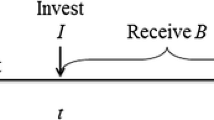Abstract
This research is motivated by the role of real options as a risk management and uncertainty filtering methodology that helps minimize downside risk and maximize upside potential of a firm's investments. It seeks to answer “why, when and how are real options used in strategic technology venturing?” This research tests for the role of real options in decision making involving three types of firms in decreasing order of technology-dependence–technology-driven (where the profit is fully dependent on new technology creation and leveraging), technology-based (where the profit is enabled and supported by technology), and technology-neutral (where the profit is almost independent of technology). It also deals with strategic, tactical, and operational types of decisions driven by real options. Finally, this research assumes an environment (business ecosystem), where co-opetitive conditions trigger the use of real options (why), that serve to transform the position, posture, and propensity of businesses to innovate, and thus they co-evolve (when) into more effective and efficient forms of businesses (co-specialization) (how).





Similar content being viewed by others
References
Bowman EH, Hurry D (1993) Strategy through the option lens: an integrated view of resource investments and the incremental-choice process. Acad Manag Rev 18(4):760–782
Bushy JS, Pitts CGC (1997) Real options and capital investment decisions. Manag Account-London 75:38–39
Cantner U, Hanusch H (2001) Heterogeneity and evolutionary change: empirical conception, findings and unresolved issues. In: Foster J, Metcalfe JS (eds) Frontiers of evolutionary economics: competition, self-organization, and innovation policy. Edward Elgar, Aldershot, pp 228–269
Carayannis E (1994) The strategic management of technological learning: transnational decision making frameworks and their empirical effectiveness. Published PhD dissertation, School of Management, Rensselaer Polytechnic Institute, Troy, NY
Carayannis EG (1998) The strategic management of technological learning in project/program management: the role of extranets, intranets and intelligent agents in knowledge generation, diffusion, and leveraging. Technovation 18(11):697–703
Carayannis EG (1999) Fostering synergies between information technology and managerial and organizational cognition: the role of knowledge management. Technovation 19(4):219–231
Carayannis EG (2000–2009) GWU SB lectures
Carayannis EG (2008) Knowledge-driven creative destruction, or leveraging knowledge for competitive advantage strategic knowledge arbitrage and serendipity as real options drivers triggered by co-opetition, co-evolution and co-specialization. Ind High Educ 22(6):343–353
Carayannis EG (2009) Firm evolution dynamics: towards sustainable entrepreneurship and robust competitiveness in the knowledge economy and society. Int J Innov Region Dev 1(3):235–254
Carayannis EG, Assimakopoulos D, Kondo M (2008) Innovation networks and knowledge clusters. Palgrave McMillan, Basingstoke
Carayannis EG, Campbell DFJ (2006) Knowledge creation, diffusion, and use in innovation networks and knowledge clusters. Praeger, Westport
Carayannis EG, Campbell DFJ (2009) ‘Mode 3’and‘Quadruple Helix’: toward a 21st century fractal innovation ecosystem. Int J Technol Manag 46(3):201–234
Carayannis EG, Gonzalez E, Wetter J (2003) The nature and dynamics of discontinuous and disruptive innovations from a learning and knowledge management perspective. In: Shavinnia LV (ed) The international handbook on innovation. Elsevier Science & Technology Books, North Holland, pp 115–138
Carayannis EG, Kaloudis A, Mariussen Å (2008) Diversity in the knowledge economy and society: heterogeneity, innovation and entrepreneurship. Edward Elgar Publishing, Cheltenham
Cimoli M, Katz J (2003) Structural reforms, technological gaps and economic development: a Latin American perspective. Ind Corp Change 12(2):387
Copeland TE, Antikarov V (2001) Real options: a practitioner's guide. WW Norton & Company, New York
Creswell JW (2003) Research design: qualitative, quantitative, and mixed methods approaches, 2nd edn. Sage, Thousand Oaks
Drucker PF (1968) The age of discontinuity: guidelines to our changing economy. Harper & Row, New York
Hull J (2008) Options, futures, and other derivatives. Pearson Prentice Hall, Upper Saddle River
Luehrman TA (1998) Strategy as a portfolio of options. Harvard Bus Rev 76(5):89–99
Merriam-Webster (Ed.) (2009) Merriam-Webster Online
Moran P, Ghoshal S (1999) Markets, firms, and the process of economic development. Acad Manage Rev 24:390–412
Porter ME (1990) Competitive advantage of Nations. Harvard Bus Rev 73:55–71
Schumpeter JA (1934) The theory of economic development. Harvard University Press, Cambridge, MA (originally published in German in 1911)
Wysocki RK (2006) Effective software project management. Wiley, New York
Author information
Authors and Affiliations
Corresponding author
Rights and permissions
About this article
Cite this article
Carayannis, E.G., Sipp, C.M. Why, When, and How are Real Options used in Strategic Technology Venturing?. J Knowl Econ 1, 70–85 (2010). https://doi.org/10.1007/s13132-010-0011-x
Received:
Accepted:
Published:
Issue Date:
DOI: https://doi.org/10.1007/s13132-010-0011-x




